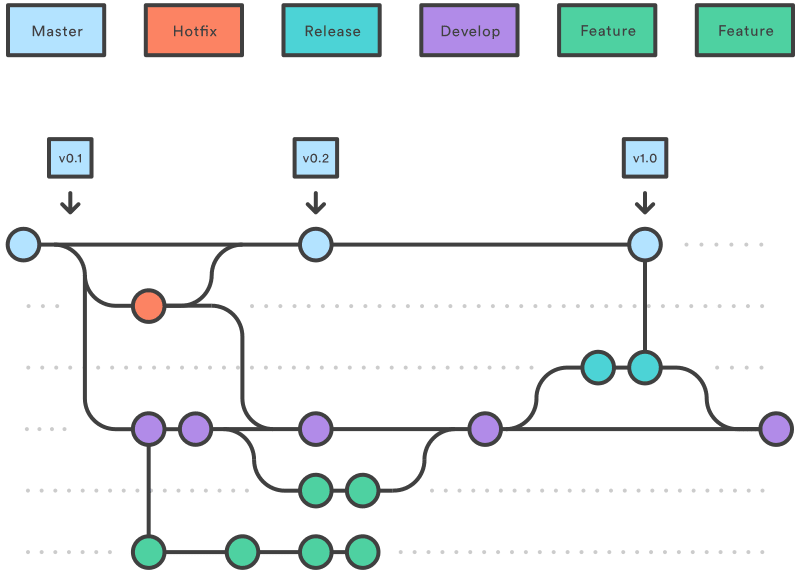Gitflow is a Git workflow design that was first published and made popular by Vincent Driessen at nvie. The Gitflow defines a strict branching model designed around the project release. This provides a robust framework for managing larger projects.
Gitflow is ideally suited for projects that have a scheduled release cycle. This workflow doesn’t add any new concepts or commands beyond what’s required for the Feature Branch Workflow. Instead, it assigns very specific roles to different branches and defines how and when they should interact. In addition to feature branches, it uses individual branches for preparing, maintaining, and recording releases. Of course, you also get to leverage all the benefits of the Feature Branch Workflow: pull requests, isolated experiments, and more efficient collaboration.
Getting started
Installation
- For MAC OS:
brew install git-flow - For Windows:
https://git-scm.com/download/win - For Linux/Ubuntu:
sudo apt-get install git-flow
Initialization
Instead of a single master branch, this workflow uses two branches to record the history of the project. The master branch stores the official release history, and the develop branch serves as an integration branch for features. It's also convenient to tag all commits in the master branch with a version number.
- Open terminal or command prompt and goto your project directory(It must be initialised with git).
-
Run
git flow initIt will ask some questions about different branches’s naming structure. Please write answers like below.
- Branch name for production releases:
master - Branch name for “next release” development:
development - Feature branches?:
feature/ - Bugfix branches?:
bugfix/ - Release branches?:
release/ - Hotfix branches?:
hotfix/ - Support branches?:
support/ - Version tag prefix?:
v - Hooks and filters directory?: press the enter
- Branch name for production releases:
Note: above options may changes as per the operating systems.
In some operation systems you won't find bugfix or support feature.
But you can manually handle that features.
Feature branches
Feature branches are used to develop new features for the upcoming or a distant future release. The essence of a feature branch is that it exists as long as the feature is in development, but will eventually be merged back into develop or discarded.
Creating a feature branch
- Run
git flow feature start <<FEATURE_NAME>>. - E.g.
git flow feature start authentication, which creates branch feature/authentication. - Do changes related to that feature and push it to origin.
Finishing a feature branch
- Run
git flow feature finish <<FEATURE_NAME>>. - E.g.
git flow feature finish authentication, which merges feature/authentication branch into development branch and delete itself from local and origin.
Summary actions
- Created off to the latest development branch.
- After Finishing feature branch, it merges into development branch and deletes feature branch from local and origin.
Bugfix branches
bugfix branches are used for bug/defect fixing.
Creating a bugfix branch
- Run
git flow bugfix start <<BRANCH_NAME>>. - E.g.
git flow bugfix start login-bug, which creates branch bugfix/login-bug. - Do changes related to bug and push it to origin.
Finishing a bugfix branch
- Run
git flow bugfix finish <<BRANCH_NAME>>. - E.g.
git flow bugfix finish login-bug, which merges bugfix/login-bug branch into development branch and delete itself from local and origin.
Summary actions
- Created off to the latest development branch.
- After Finishing bugfix branch, it merges into development branch and deletes bugfix branch from local and origin.
Release branches
Release branches support preparation of a new production release. They allow preparing meta-data for a release (version number, build dates, etc.). By doing all of this work on a release branch, the develop branch is cleared to receive features for the next big release.
Creating a release branch
- Run
git flow release start <<VERSION_NUMBER>>. - E.g.
git flow release start 0.0.1, which creates branch release/0.0.1. - Do changes related to releasing and push it to origin.
Finishing a release branch
- Run
git flow release finish <<VERSION_NUMBER>>. - E.g.
git flow release finish 0.0.1. - It will ask for release tag message, write proper tag description.
- E.g.
********************************************************
V0.0.1
- Integrated Authentication
- Implemented Login flow
********************************************************
- It creates tag v0.0.1.
- Release branch merges into development and master branches and deletes it self from local and origin.
- Don’t forget to push development and master to push to origin.
- Create a tag into github / gitlab / bitbucket and provide a tag message.
- Create a release / change_log into github / gitlab / bitbucket and provide a proper release message.
- Deploy your changes from master to production.
- It helps to record your release history very well.
Summary actions
- Created off to the latest development branch.
- After Finishing release branch, it merges into master and development branches and deletes release branch from local and origin.
- Creates release tags which helps to record release history.
Hotfix branches
Hotfix branches are very much like release branches in that they are also meant to prepare for a new production release, albeit unplanned. They arise from the necessity to act immediately upon an undesired state of a live production version. When a critical bug in a production version must be resolved immediately, a hotfix branch may be branched off from the corresponding tag on the master branch that marks the production version. It uses for maintenance or quick patches after release.
Creating a hotfix branch
- Run
git flow hotfix start <<VERSION_NUMBER>>. - E.g.
git flow hotfix start 0.0.2, which creates branch hotfix/0.0.2. - Do changes related to hotfix and push it to origin.
Finishing a hotfix branch
- Run
git flow hotfix finish <<VERSION_NUMBER>>. - E.g.
git flow hotfix finish 0.0.2. - It will ask for release tag message, write proper tag description.
- E.g.
********************************************************
V0.0.2
- Quick patches
********************************************************
- It creates tag v0.0.2.
- Hotfix branch merges into development and master branches and deletes it self from local and origin.
- Don’t forget to push development and master to push to origin.
- Create a tag into github / gitlab / bitbucket and provide a tag message.
- Create a release / change_log into github / gitlab / bitbucket and provide a proper release message.
- Deploy your changes from master to production.
- It helps to record your release history very well.
Summary actions
- Created off to the latest master branch.
- After Finishing hotfix branch, it merges into master and development branches and deletes hotfix branch from local and origin.
- Creates release tags which helps to record release history.
Support branches
Next to the main branches master and develop, our development model uses a variety of supporting branches to aid parallel development between team members, ease tracking of features, prepare for production releases and to assist in quickly fixing live production problems. Unlike the main branches, these branches always have a limited life time, since they will be removed eventually.
Creating a support branch
- Run
git flow support start <<SUPPORT_BRANCH_NAME>> <<EXISTING/ORIGIN/PARENT_BRANCH_NAME>>. - E.g.
git flow support start stage-development developmentwhich creates support/stage-development branch from development. - Don't forget to push support branch to origin.
Summary actions
- Created off to the provided existing branch.
- The different types of branches we may use are:
- Feature branches
- Release branches
- Hotfix branches
At the core, the development model is greatly inspired by existing models out there. The central repo holds two main branches with an infinite lifetime:
- Master
- Development










Top comments (0)